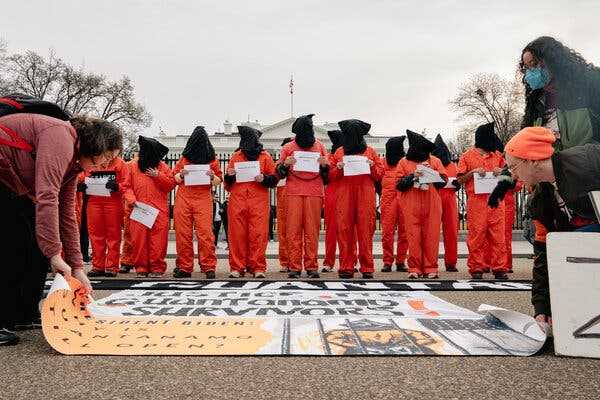Abu Zubaydah was captured in a raid in Pakistan in 2002 and has been held at the U.S. Navy base without charges since 2006.
-
Send any friend a story
As a subscriber, you have “>10 gift articles to give each month. Anyone can read what you share.
Give this article

A group opposed to the detention center at Guantánamo Bay protesting in front of the White House in January.
A U.N. human rights panel has urged the United States to immediately release Abu Zubaydah, a prisoner at Guantánamo Bay and the first detainee waterboarded by the C.I.A. after the Sept. 11, 2001, attacks.
The U.N. Working Group on Arbitrary Detention also said that after studying other cases at Guantánamo over the past 15 years, it had seen a pattern that could “constitute crimes against humanity.”
The prisoner, whose real name is Zayn al-Abidin Muhammed Husayn, was captured in a raid in Pakistan in 2002 and has been held at the U.S. Navy base in Cuba without charges since 2006.
The United States has argued that its basis for holding him indefinitely in the war against terrorism is that, although he was never a member of Al Qaeda, he helped jihadists reach Afghanistan for training before the Sept. 11 attacks.
The body, which has no enforcement mechanism, also found that Abu Zubaydah had been denied a meaningful review of his detention and so was being unlawfully held. “The appropriate remedy would be to release Mr. Zubaydah immediately and accord him an enforceable right to compensation and other reparations, in accordance with international law,” the group said in an opinion.
He was the first prisoner of a C.I.A. “black site,” a global network of overseas, secret prisons that held more than 100 men beyond the reach of U.S. law and the International Committee of the Red Cross from 2002 to 2006.
Two C.I.A. contract psychologists devised a torture program of “enhanced interrogation techniques,” specifically for use on him in an agency prison in Thailand, in which he was waterboarded, deprived of sleep and confined in a coffinlike box.
In 2019, Abu Zubaydah drew sketches of how he was tortured. His lawyers made the drawings public, with the face of an interrogator redacted behind a black box.
ImageAbu Zubaydah.
The report criticized six other nations where the United States held Abu Zubaydah — Pakistan, Afghanistan, Thailand, Poland, Morocco and Lithuania. In 2018, the European Court of Human Rights censured Lithuania and Romania for their complicity in the C.I.A. program.
The U.N. also denounced Britain, whose intelligence agencies had U.S. interrogators question the prisoner at black sites despite its knowledge of his “extreme mistreatment.”
It was the latest in a series of condemnations of the United States released since the U.N. group, which is based in Geneva, adopted the 19-page opinion in November. The document was made public on Friday.
Other U.N. human rights investigations have been sharply critical of U.S. military health care at the wartime prison and a policy that considers detainee artwork the property of the U.S. government.
Abu Zubaydah’s lawyer, Lt. Col. Chantell M. Higgins, a U.S. Marine, said the condemnation should provide “a greater incentive for the United States to find a place for him to go, and release him.”
Although born in Saudi Arabia, Abu Zubaydah is a Palestinian with no immediate country to receive him.
Helen Duffy, an international human rights lawyer who brought his case before the U.N. body, said on Monday that Abu Zubaydah “has a well-founded fear of further violations if sent to Saudi, and we hope to engage with the United States and other states on alternative sites of relocation.”
Colonel Higgins suggested that Qatar might be a suitable location, noting that the country “has been generous and successfully taken in foreigners detained at Guantánamo.”
Source: nytimes.com



